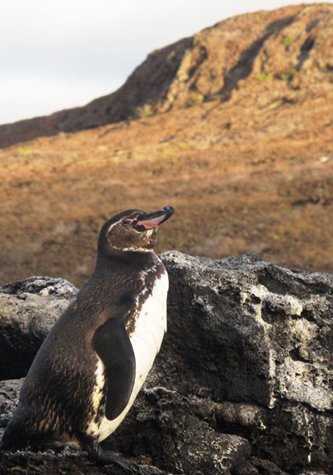Today, we woke up to a typical September day: overcast with some breeze in the early morning that later turned out to be a sunny day, with pleasant air and sea temperatures. First on our schedule was a hike to the summit of Bartolomé, a small island located off the eastern coast of Santiago. This small island holds more than 200 craters of various sizes, as well as the most famous landmark of the Galápagos: Pinnacle Rock. A boardwalk and then about 300 wooden steps led us to the top of Bartolomé, from which the views of the lava fields of the island and the surrounding coasts were simply astonishing.
After this climb, we returned to the ship for a well-earned breakfast and then prepared for a landing at the orange-tinged beach by Pinnacle Rock. For the remainder of the morning, this would be our base from which we could relax, walk on the soft sand, swim in the blue waters, or explore the very rich underwater world by snorkeling nearby. The place is extremely rich with sea life, with large schools of various species of fish. Some were colorful, others not as much, but the abundance was fantastic. We spotted razor surgeonfish, Cortez rainbow wrasses, pink cardinal fish, sergeant majors, and beautiful blue-chin parrotfish. Sea stars are also found here, such as the Panamic cushion and the chocolate chip sea star—always a favorite because of its appealing name and shape.
On the beach, many of us were surprised by the sudden appearance of a juvenile Galápagos hawk. Like all young, he seemed curious and inquisitive. He landed on the sand and walked toward the vegetation, perhaps to follow a lava lizard or another potential prey, but not before allowing us to photograph it and admire its beauty and innocence.
In the afternoon we had another destination to explore. The National Geographic Endeavour navigated further south along the Santiago Island coast to reach a group of small islets. One of them is Sombrero Chino, named after its peculiar shape which resembles a typical Chinese hat. A narrow channel with turquoise and tranquil waters separates this islet from the Santiago coast. Many guests took another opportunity to snorkel here. With relatively clear waters, they had close encounters with many fish species, even spotted eagle rays and white-tipped reef sharks. Toward the end of the afternoon we returned to this area to look for the ever charismatic Galápagos penguin. This is the third smallest penguin in the world, and a small colony inhabits these shores. We were successful, as we found four of them on the rocks near their lava homes, drying their plumage in the dying light of the afternoon. The setting sun spread its beautiful yellow light on the nearby coast, islets and islands. We felt the peace of this magic place around us. What a wonderful way to end the day!







